PDA IB Lecture 2 and 3: Drug Formulations & Administration
1/85
There's no tags or description
Looks like no tags are added yet.
Name | Mastery | Learn | Test | Matching | Spaced |
|---|
No study sessions yet.
86 Terms
What does a finished dosage form contain?
- contains a drug substance, not necessarily in association with other API or inactive ingredients
(capsule contains drug substance with other non-drug/inert substances, excipients.)
Active Pharmaceutical Ingredient (API)
The drug product component that produces the pharmacological activity
- Drug substances bring about a change in a....
- What purposes does this change serve? (4)
- biological function through their chemical action(s)
- diagnose, mitigate, treat or prevent a certain disease-state
Excipients
- the non-drug or inert substance component(s) of a dosage form
(include vehicle, diluents, disintegrant, lubricant, binder, antioxidant, coloring & flavoring agents, etc)
What does the dosage form determine? (3)
- the route of administration
- the clinical efficacy
- safety of the drug
T/F: A drug may exist in different dosage forms
TRUE

Examples of solid dosage forms
Tablets, Capsules, Caplets, Lozenges/troches, Pastilles, Powders, and Granule
Advantages of solid dosage forms (4)
• Increase Stability
• Ease of packaging, storage, and dispensing (convenience)
• Little or no taste or smell
• Accurate dosing
Disadvantages of solid dosage forms (2)
• A slow onset of action
• May be degraded by the acidic contents in the stomach (Oral)
Liquid dosage forms are described as.....
One or more active ingredients in a liquid vehicle such as a solution (drop, syrups), suspension, or emulsion
Advantages of liquid dosage forms (4)
• Easier dosage adjustments, particularly for pediatric patients
• Easier to swallow (pediatric & geriatric patients)
• onset of action is faster than solid dosage forms
• Easier for feeding tube
Disadvantages of liquid dosage forms (5)
• Loss of potency occurs faster than with solid dosage form
• Difficult to mask bitter taste/odor
• Preservatives needed
• Potential for dosing inaccuracy
• Inconvenient
What are semisolid dosage forms are intended for?
What are they in the form of?
- topical application
- ointments, creams, paste, and gels, etc.
Ointments
- intended for ___________ use
What are they used as? (3)
- intended for external use.
used as:
1) emollients to make the skin more pliable
2) protective barriers to prevent harmful substances from coming in contact with the skin
3) vehicles to incorporate medication
Suppositories
- solid (or semi-solid) dosage form intended to be inserted into a body orifice
- mostly local effects, can also be systemic
- drug is released after the suppository melts or dissolves
Aerosol formulation ****
what 2 components do they consist of?
they are designed to deliver drugs _________________ or ___________ with the aid of a ____________________
pressurized dosage forms (inhalation)
- consists of two components: the product concentrate and the propellant *********
- deliver drugs systemically or topically with the aid of a liquefied or propelled gas (propellant)
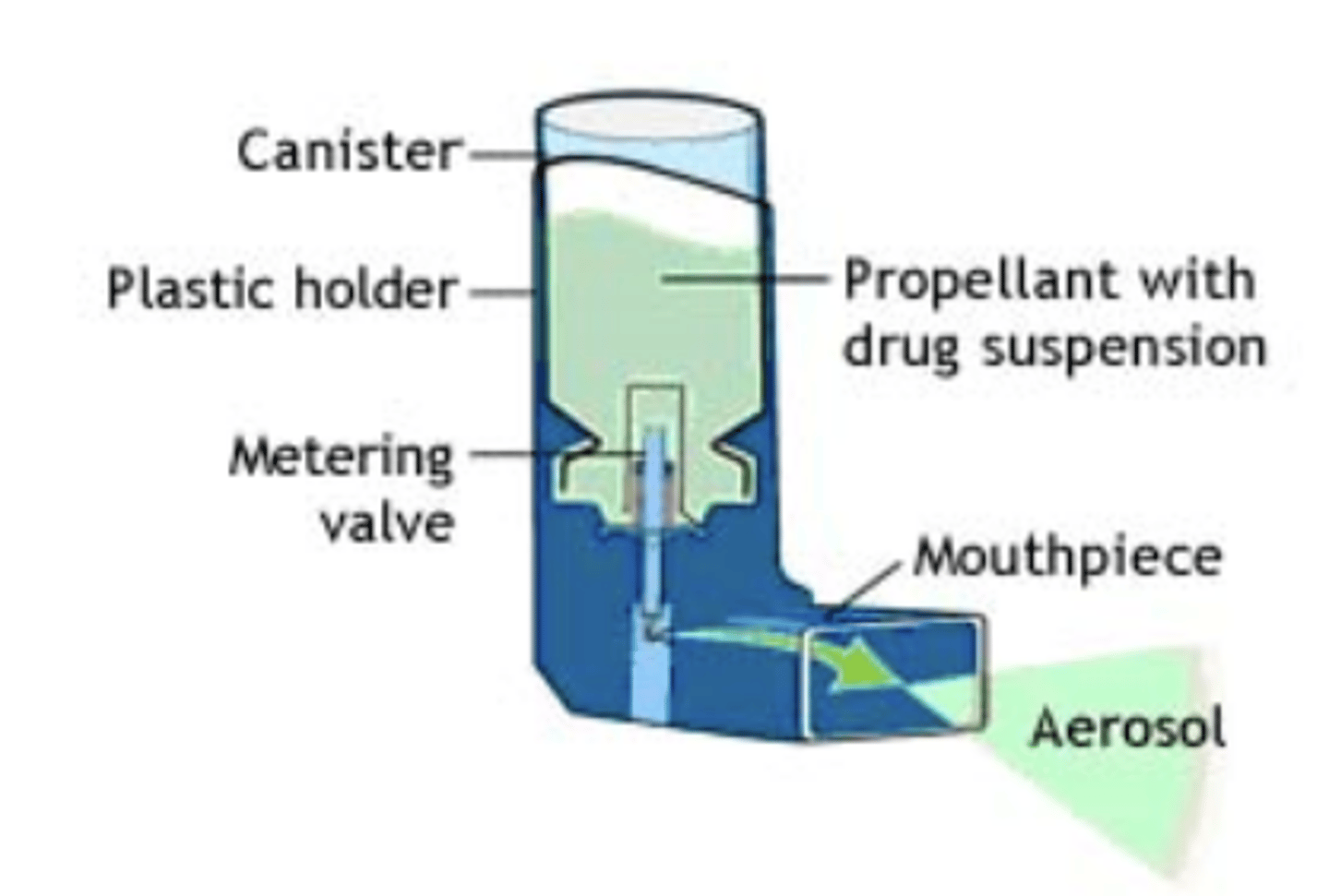
The product concentrate
the active drug combined with additional ingredients or co-solvents required to make a stable and efficacious product
Propellant
liquefied or propelled gas that helps deliver dose
Systemic or pulmonary drug delivery is provided by ______________________, devices that allow a drug to be inhaled as a _________________________________________________
- metered dose inhalers (MDI)
- fine mist of drug or drug-containing particles
Transdermal Dosage Forms
- holds specific amount of drug to be released into the skin and absorbed into the bloodstream
- Applied easily and minimize stomach upset
- Reduce the need for more frequent dosing
Transdermal Dosage Forms prevent...
extensive metabolism in the GI tract or liver
What is a common medication error?
Switching from one dosage form to another
- Dosage conversion
When converting from oral to IV medications and vice versa, it is often not a......
1 to 1 conversion
T/F: In oral administration, more parts of the effective elements of a drug will be lost rather than parental administration
TRUE
T/F: Commercially available dosage formulations often expand the drugs that
can be prescribed to children and are child friendly
FALSE
Commercially available dosage formulations often limit the drugs that can be prescribed to children and are not always child-friendly
Many drugs are available only as an oral tablet, capsule, or intravenous dilution in....
adult dosage strengths
- Dose adjustment needed
- dosage adjustments are essential to avoid adverse drug events in children
What issues can difficulty swallowing a whole or intact tablet or capsule lead to?
can lead to attempting to break tablet into smaller pieces or emptying part of a capsule to provide an appropriate dose, leading to questionable accuracy of the administered dose
How can the issue of a dosage formulation that is not commercially available for a pediatric patient be addressed?
A pharmacist who is willing and able can compound accurate pediatric drug dosages and formulas
Enhanced dosing content for _______________ helps with dose adjustments
patient-specific factors (age, weight, kidney and liver function)
What is the most common method for dose adjustment in children?
to normalize the adult dose by body weight, assuming a linear relationship between weight and dose (weight: kg or lbs.)
T/F: Comprehensive dose assessment in pediatric patients require less steps than in adult patients
FALSE
- requires several more steps than in adult patients (PK differences, physical factors, and medication administration)
2 of several different methods of calculating pediatric dosages
- Clark's Rule
- Young's Rule

Clark's Rule
uses weight in Ibs, NEVER in Kg
Adult dose x (Weight/150) = Child's dose
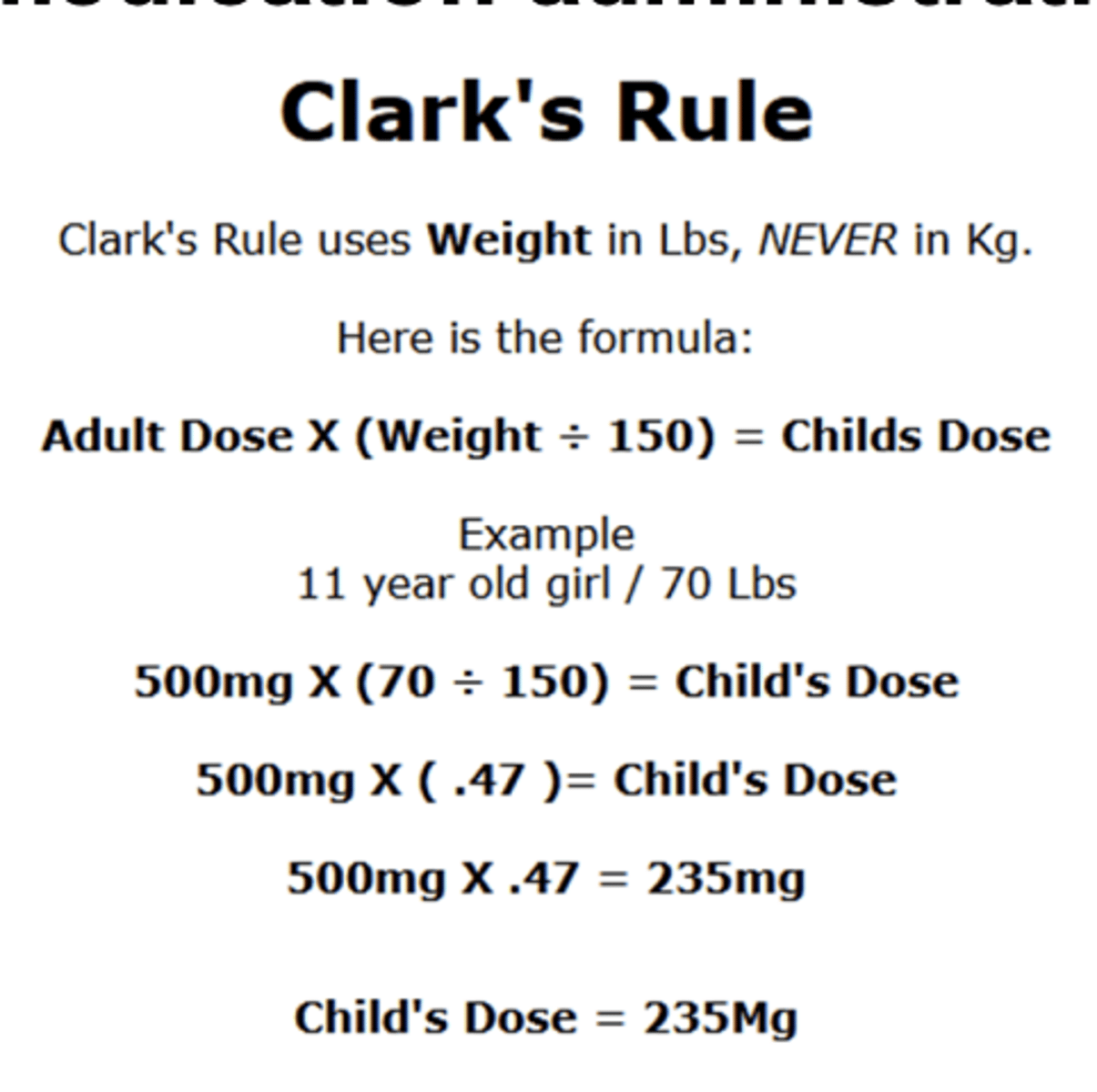
Young's Rule
uses age
Adult dose x (Age/(Age + 12)) = Child's dose
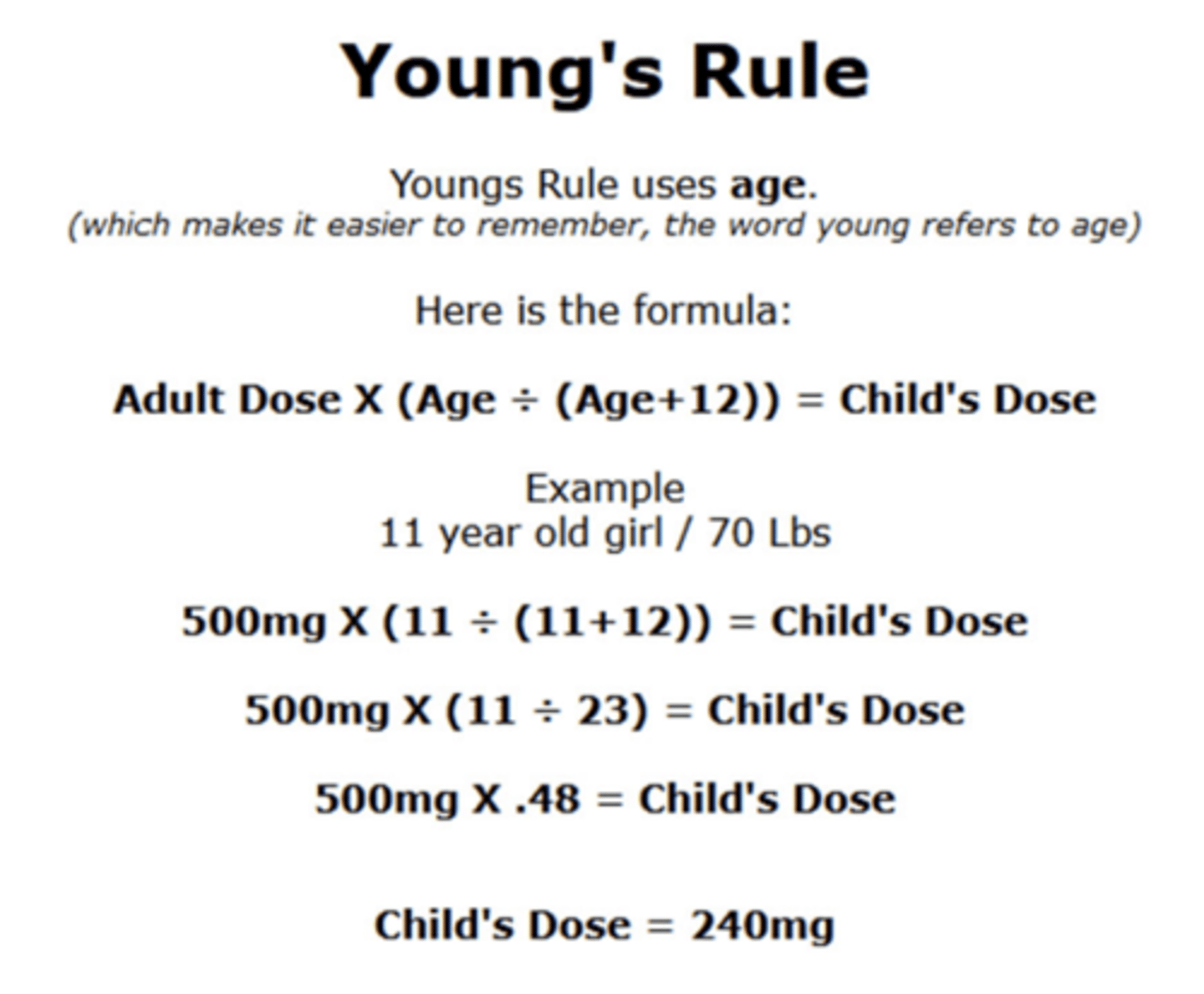
_________________ plays a critical role in the BA and PK of a drug
Dosage form
What is the route of drug administration dependent on? (2)
- the dosage form of drug
- disease state (same drug may exist in different dosage forms)
T/F: Specific dosage forms may be required for certain drugs
TRUE
(e.g., insulin is not given orally because it is digested in stomach)
Route of administration
the path by which a drug, fluid, poison or other substance is brought into contact with the body
Routes of administration are chosen to enable the drug to....
penetrate barriers presented by the body (cell membranes)
_____________________________ and ______________ are aspects of drug delivery
- Route of administration
- dosage form
Why is the route of drug admin. important? (5)
- Absorption
- Bioavailability
- Reduce toxicity
- Patient's condition (age, disease stage)
- Nature of drug (physical/chemical properties)
Enteral administration
drug administration via the human gastrointestinal tract
- intended effect: systemic
- first-pass effects
- oral, sublingual, buccal, rectal

Parenteral route
refers to any routes of administration that do not involve drug absorption via the gastrointestinal tract

Stomach pH
1-3
Intestinal pH
6-8
Enteric-coated tablet
Coated with a polymer barrier that prevents the drug from being broken down in the stomach
- or protects the lining from the drug (dissolves in alkaline pH of intestine)
- (e.g., aspirin potassium Cl)
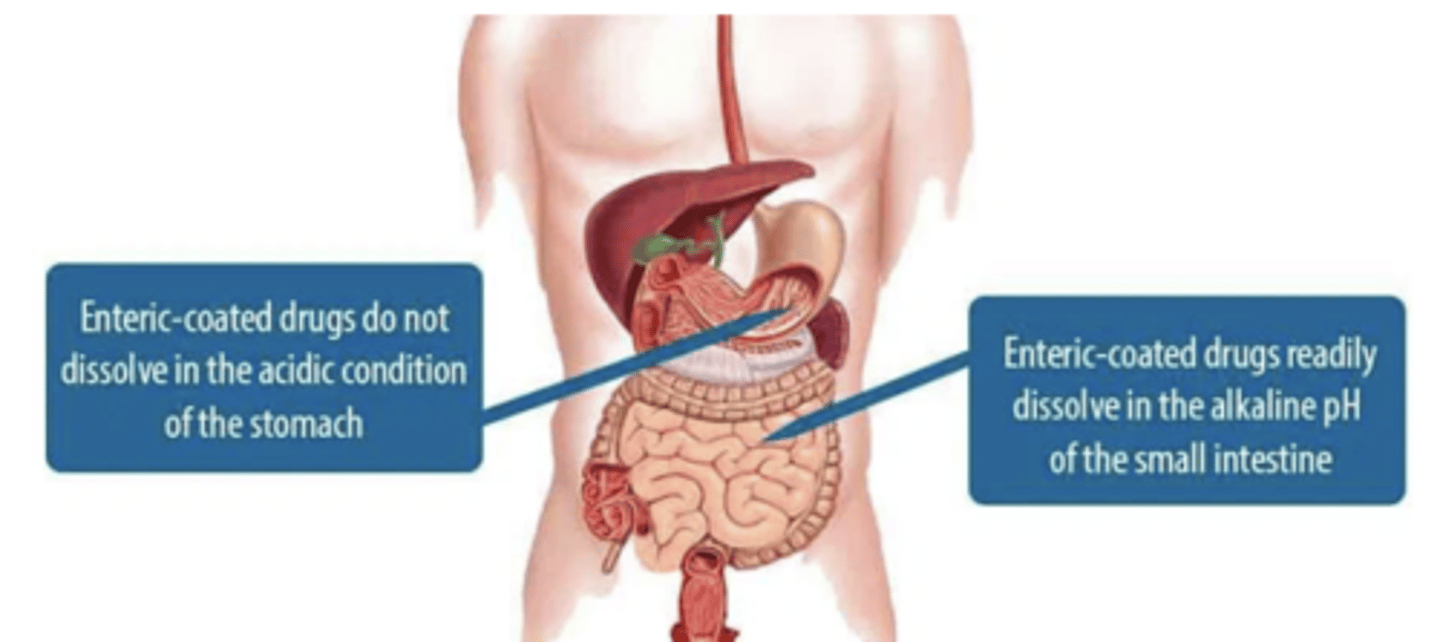
An orally administered drug must be _____________ during its absorption across the GI tract epithelium
stable
Drugs must usually traverse the cell membrane at both _________ and _____ surfaces before entering the blood
- apical and basal
The efficiency of this absorption is determined by....
drug size and hydrophobicity (and sometimes presence of carriers)
********Which drugs cross membranes more efficiently?
What circumstances may this not be the case?
*****hydrophobic and neutral drugs (lipophilic)**
- unless the membrane has a carrier molecule that facilitates the passage of hydrophilic substances
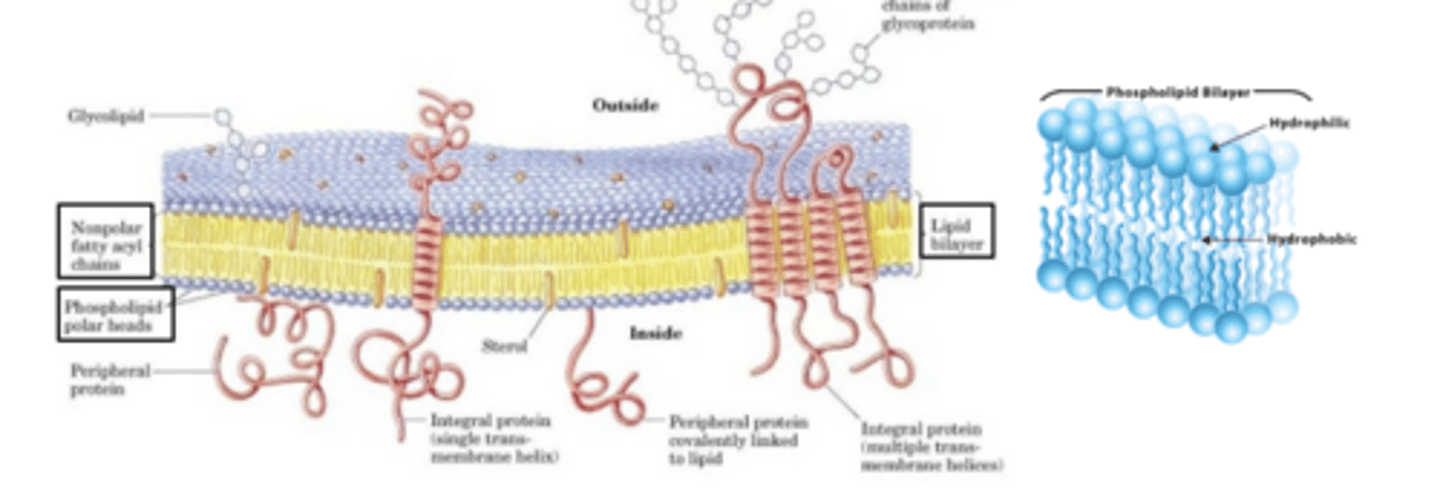
Advantages of enteral route (3)
– Convenient, easy self administration
– Safer, less likely to introduce a systemic infection
– Less expensive
Disadvantages of enteral route (5)
– Slow onset of action
– Inactivation by stomach acid/enzyme
– Chemical interaction (food)
– Irritation of GI tract (GIT)
– First-pass metabolism (oral route)
Hepatic First-Pass Metabolism
drugs undergo extensive metabolism in the liver, as they are transported for the first time via the portal system
- liver can excrete drug into bile (biliary excretion)

T/F: ALL oral drugs are subject to first-pass metabolism
TRUE
The greater the first-pass effect, the....
- drugs easily metabolized have a ...
less amounts of the drug reach circulation
- drugs easily metabolized have a large first-pass effect and low BA
First-pass not only occurs in the liver, but can also occur in...
gastrointestinal (GI) epithelial cells
- Sublingual and Buccal Mucosa Routes
- What is their target?
- What dosage forms do they come in?
- drugs diffuse through the oral mucosa and enter the bloodstream directly
- target: systemic
- dosage form: tablet, liquid (oral spray)
(e.g., fentanyl, nitroglycerin)

Advantages of sublingual and buccal mucosa routes (2)
- Bypass first-pass
- Rapid onset
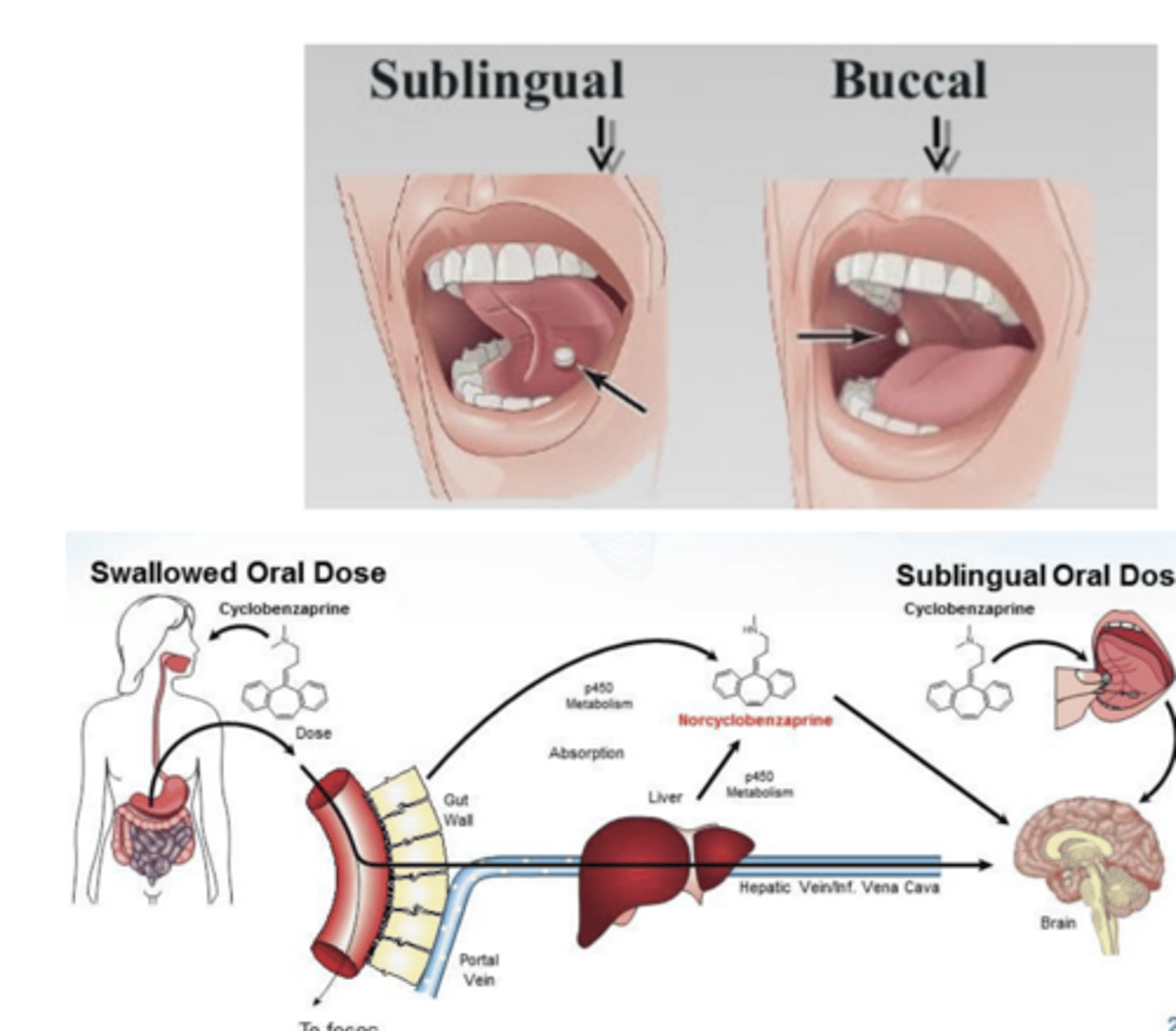
Disdvantages of sublingual and buccal mucosa routes (3)
- Bad taste
- Many drugs do not penetrate oral mucosa
- Not used for irritating substances
Rectal Route
- Dosage form:
- Target:
Dosage form: suppository, cream
Target: local and systemic
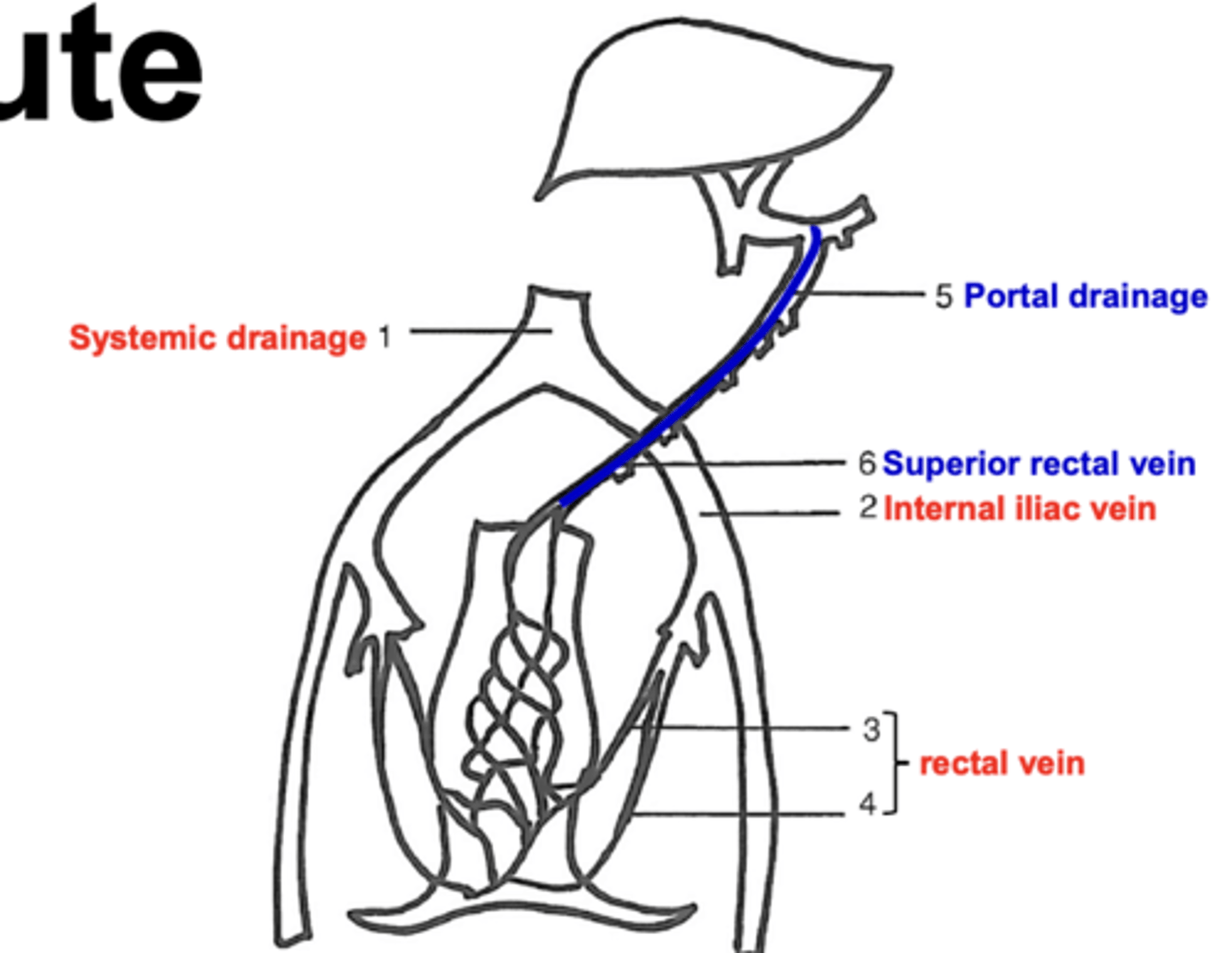
Advantages of rectal route (4)
- bypasses around 2/3 of first-pass metabolism (still undergoes somewhat, 1/3)
- drug reaches circulation with less alteration and in greater concentrations compared to PO
- rapid onset (comp. to PO)
- children, vomiting, PTs with digestive tract motility problems, unconscious PTs
Disadvantages of rectal route (3)
- Inconvenient
- Absorption variable
- May cause irritation or inflammation of rectal mucosa
Parenteral Routes
- drug introduced directly across body's barrier into circulation or tissue space
- onset differs among sub-routes, depends on rate of blood flow to tissue or site of admin.
Examples of parenteral routes: (5)
1. Intravenous (IV)
2. Intramuscular (IM)
3. Subcutaneous (SC)
4. Intradermal (ID)
5. Intraperitoneal (IP) - injection of a substance into the peritoneum (body cavity).
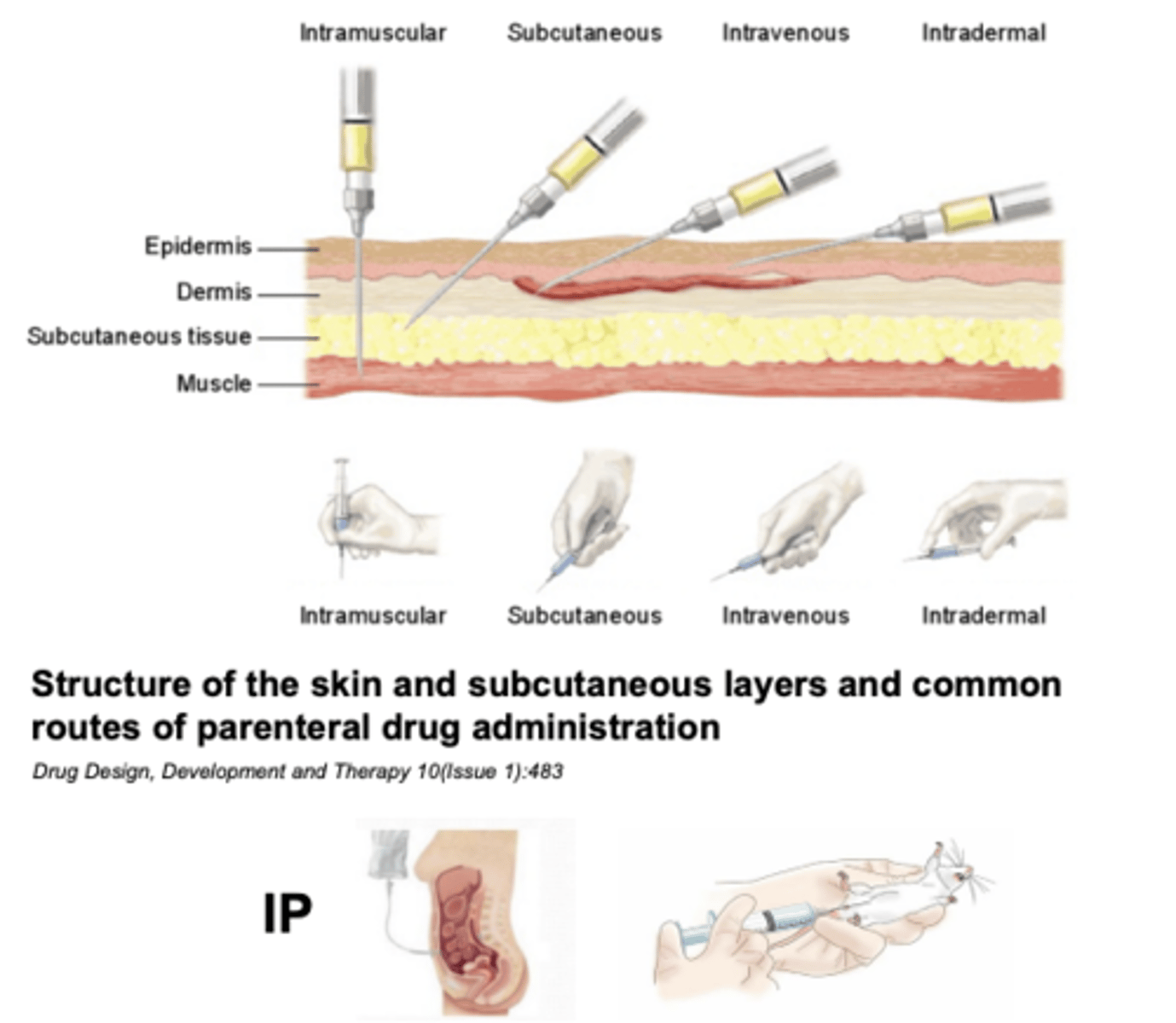
Injections MUST be.....
sterile and pyrogen free
Advantages of parenteral route (6)
- fast onset (IV>IM>SC)
- valuable in emergency
- bypass first-pass (exception: IP)
- Increased BA
- better control of delivered dose
- useful when unconscious or with GI issues
Which injection that does NOT avoid first pass?
intraperitonial (IP)
Disadvantages of parenteral route (8)
- maintenance of sterility >> high cost
- inconvenient, painful (SC)
- no retreat, more caution (IV)
- Anaphylactic reactions more dangerous
- absorption erratic in obese & during exercise (IM, SC)
- Difficult to perform (IV, obese)
- requires healthcare prof.
- increased risk of infection
T/F: Topical drug administration does have first-pass effects
FALSE
- topical drug admin. does NOT have first-pass effects
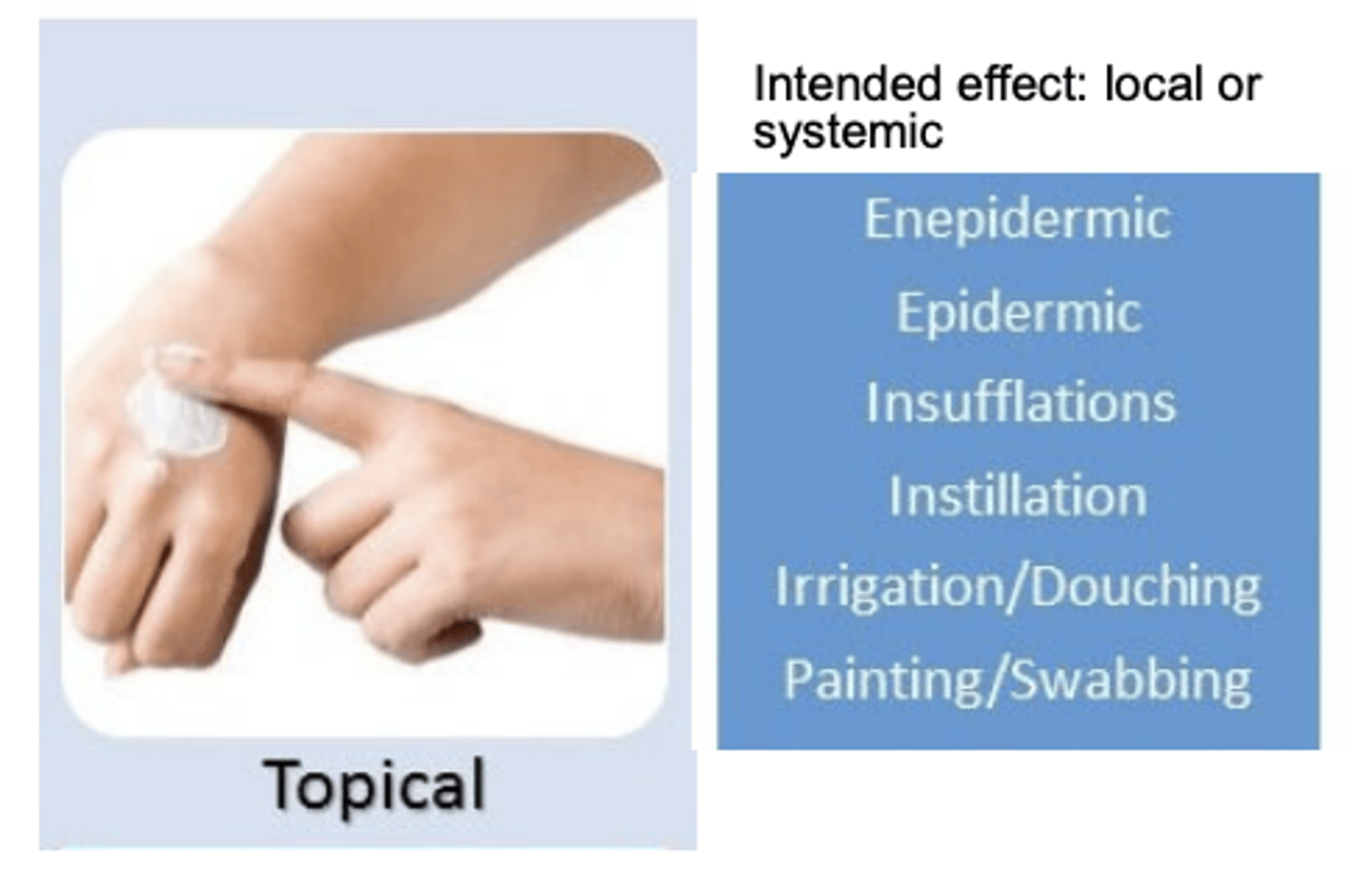
Do drugs administered via topical routes have improved BA compared to oral drugs? why?
- topical has improved BA
- bypasses first-pass
(absorption and onset of action more rapid than oral drugs)
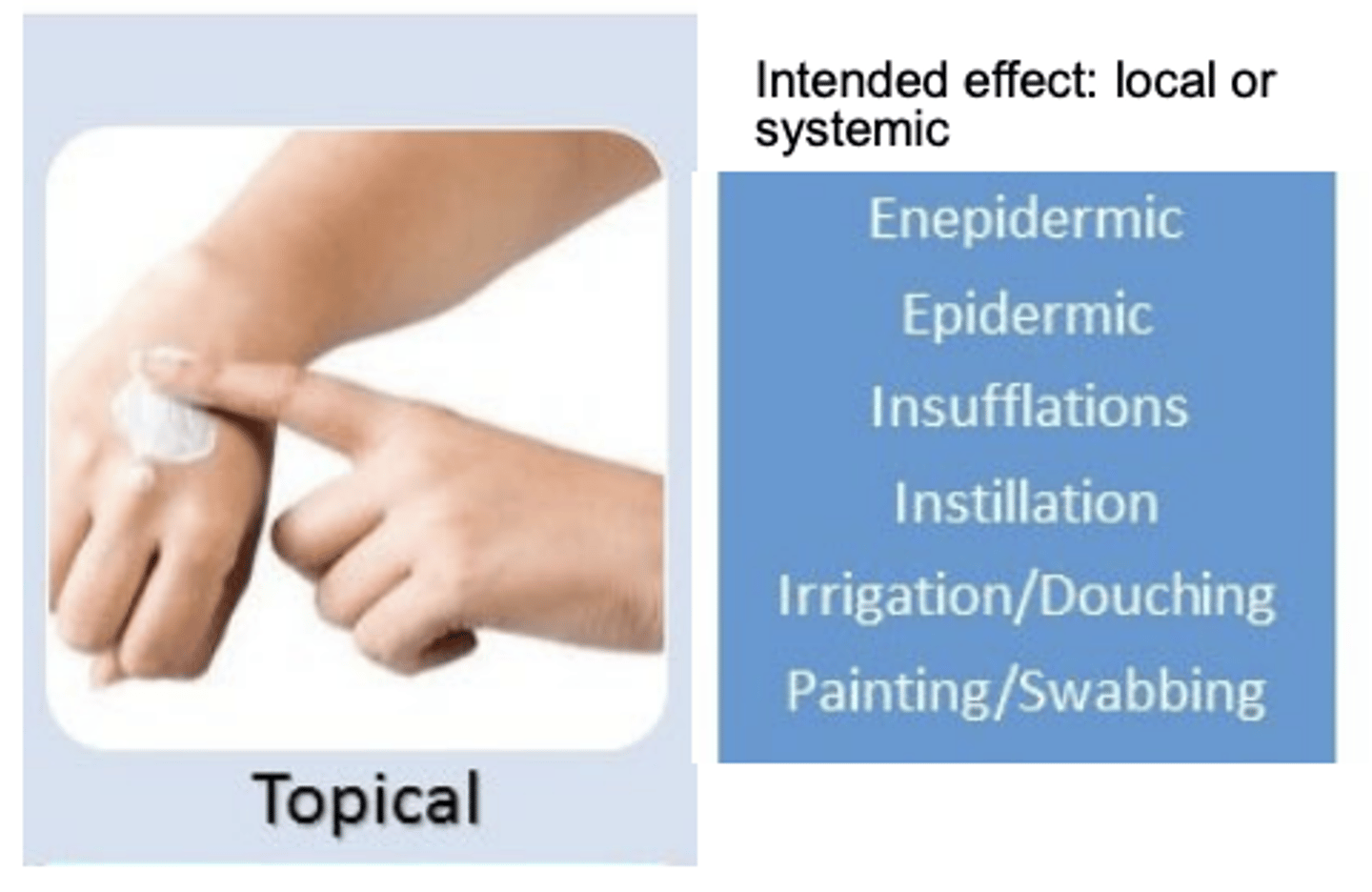
T/F: Inhalation drug administration does not have first-pass affects
FALSE
- inhalation drugs CAN have first-pass effects (not caused by liver, but cells in lung)
- pulmonary drug metabolism
-
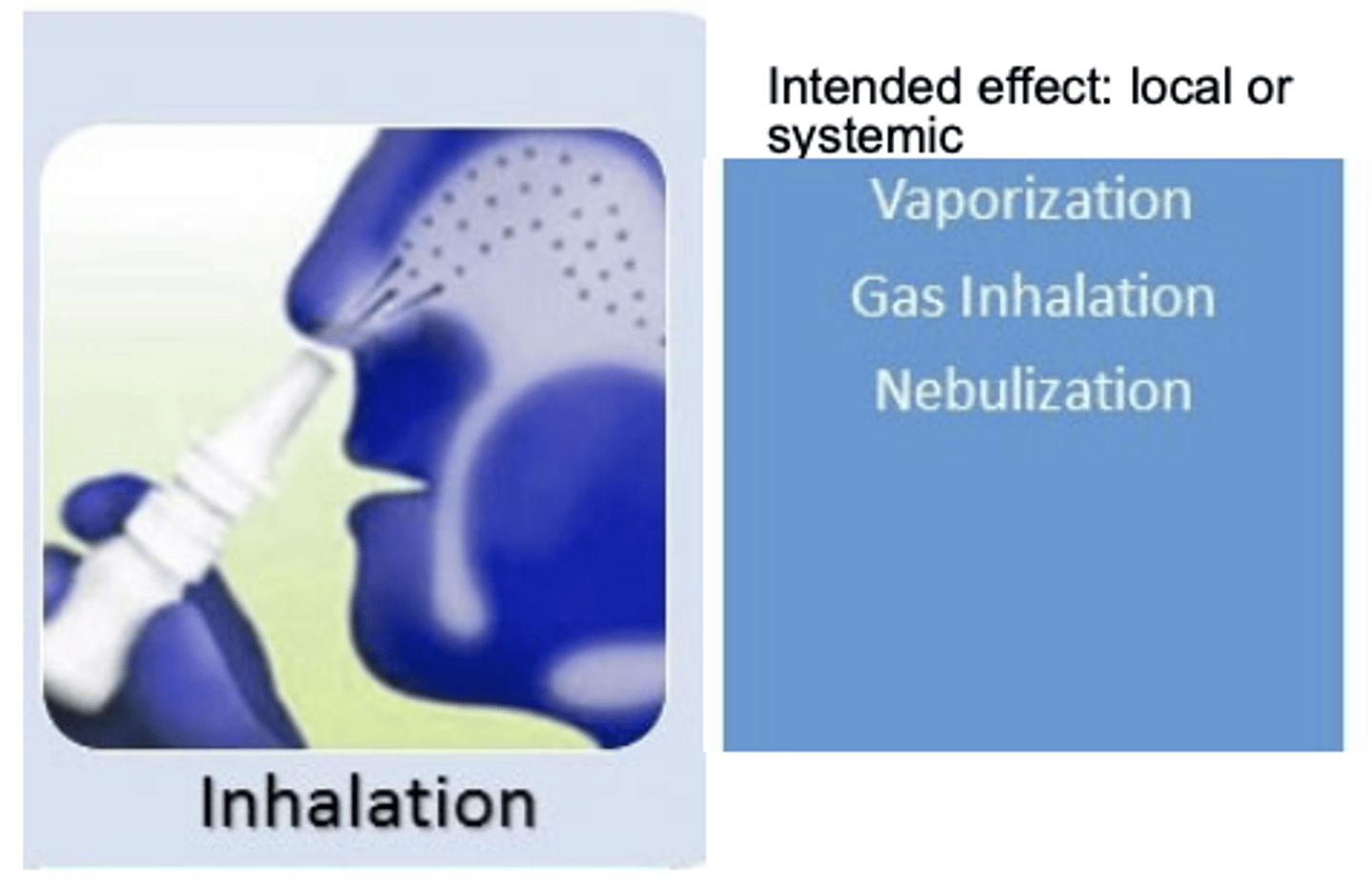
What does pulmonary drug metabolism lead to? (2)
suboptimal efficacy or increased risk of adverse effects
What are advantages of inhalation drugs?
- less frequent dosing than oral & injectable forms
- bypasses first-pass in liver, leading to higher BA for certain drugs (pulmonary metabolism not as extensive as liver
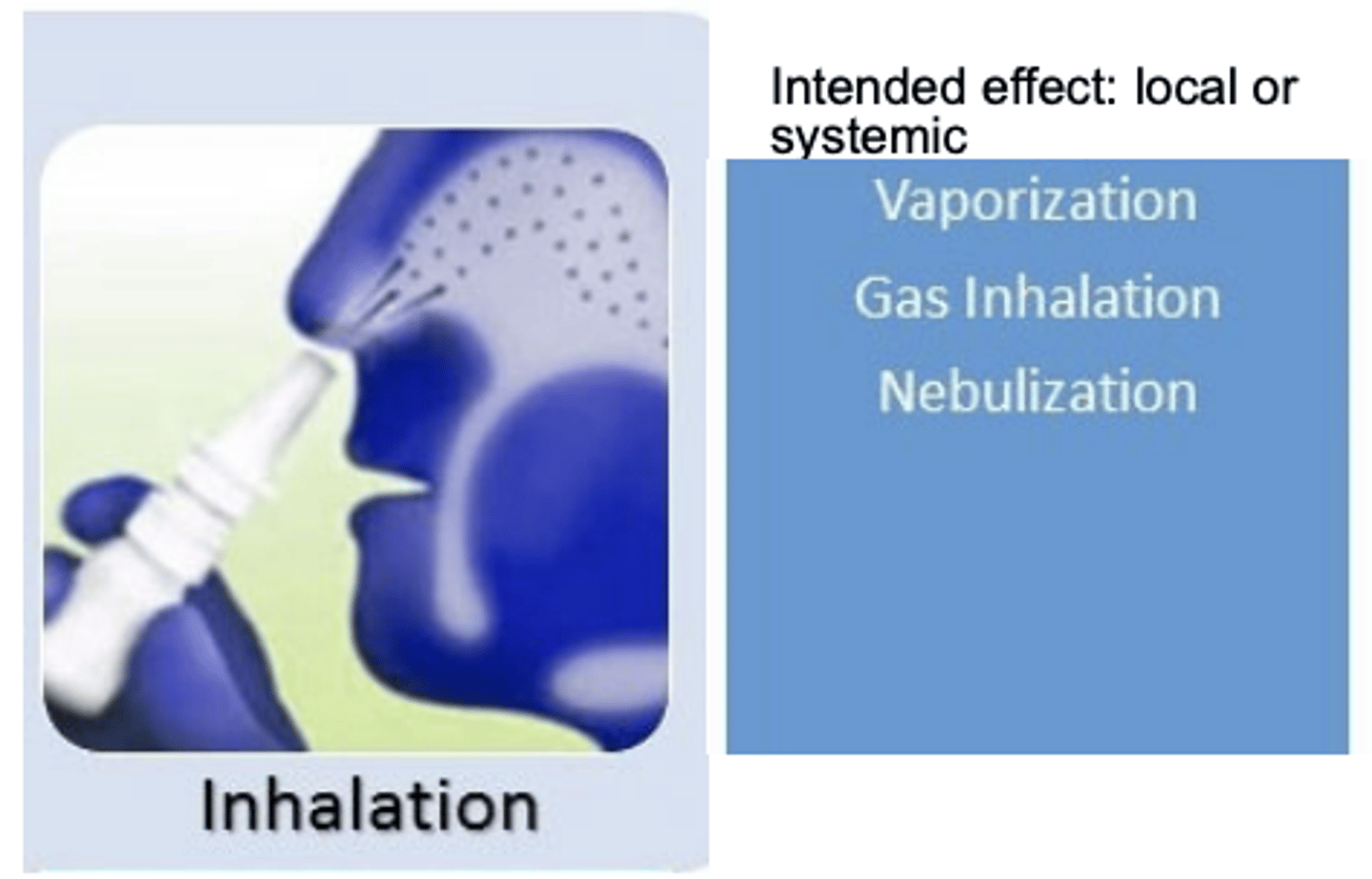
Comparison of different routes (chart) ***
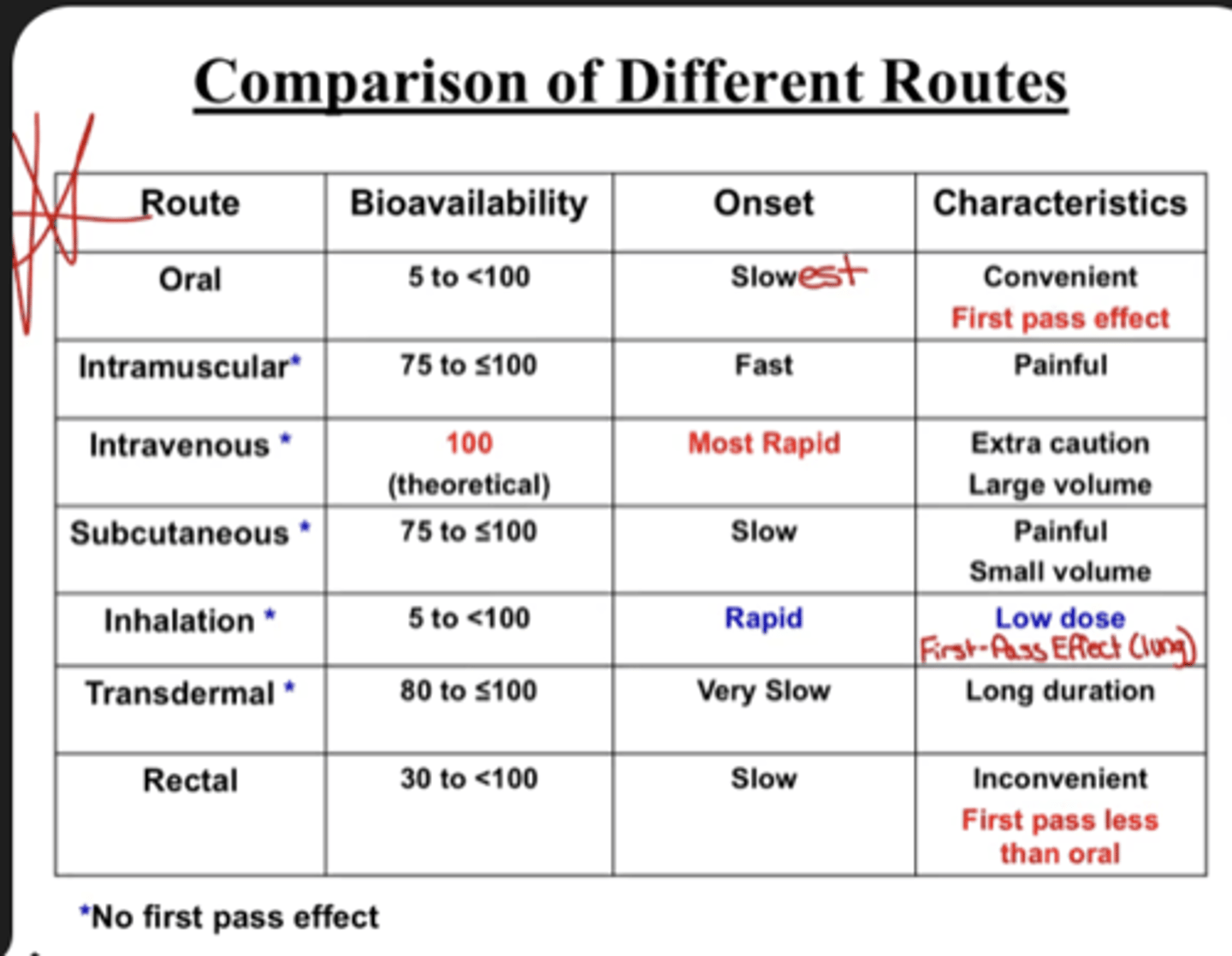
Comparison of different routes (chart) ***: ORAL
Bioavailability:
Onset:
Characteristics (2):
Bioavailability: 5 to <100
Onset: Slowest
Characteristics: convenient, first-pass effect

Comparison of different routes (chart) ***: Intramuscular IM
Bioavailability:
Onset:
Characteristics (1):
Bioavailability: 75 to <100
Onset: Fast
Characteristics (1): Painful
- NO FIRST-PASS
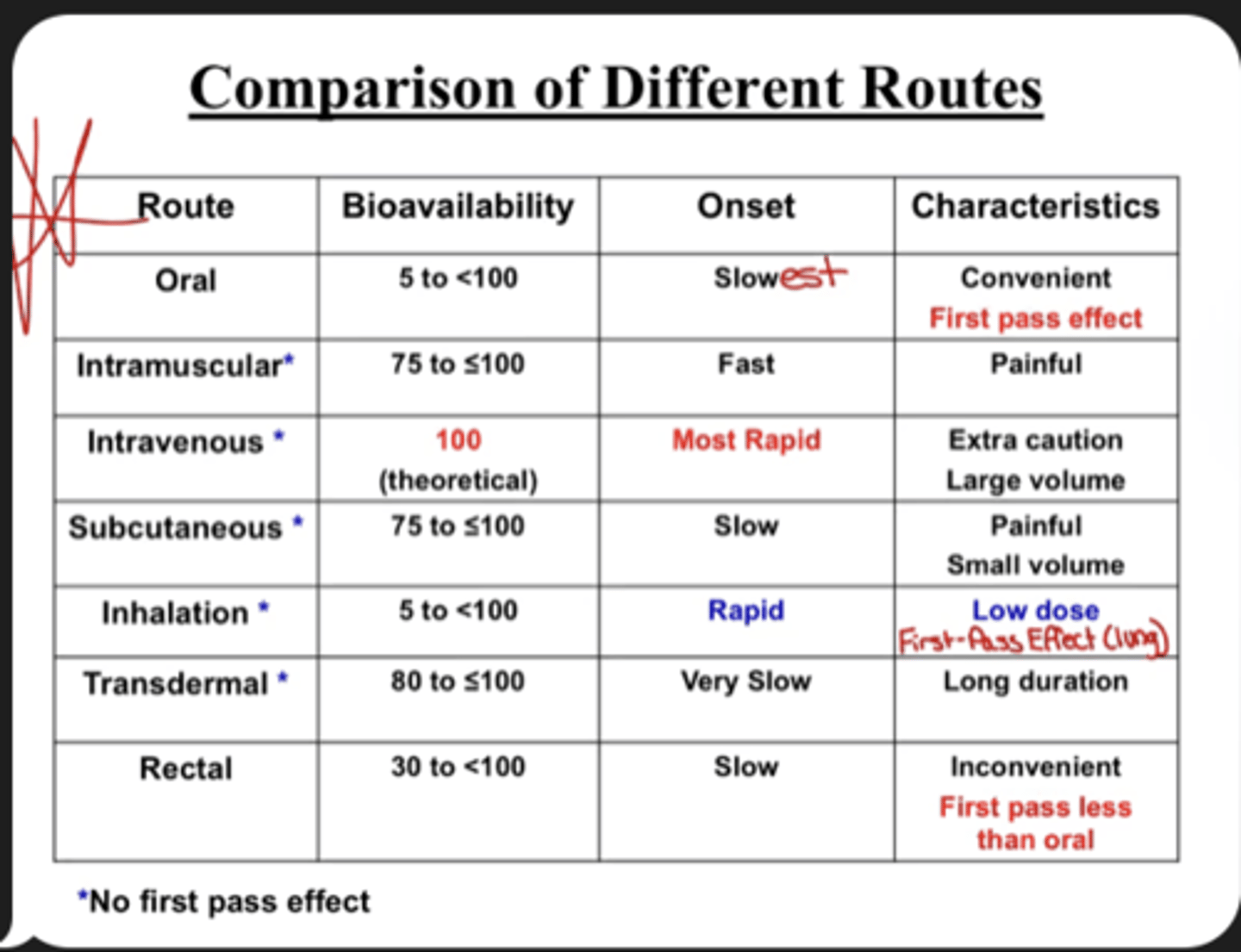
Comparison of different routes (chart) ***: Intravenous IV
Bioavailability:
Onset:
Characteristics (2):
Bioavailability: 100 (theoretical)
Onset: Most rapid
Characteristics: extra caution, large volume
- NO FIRST-PASS
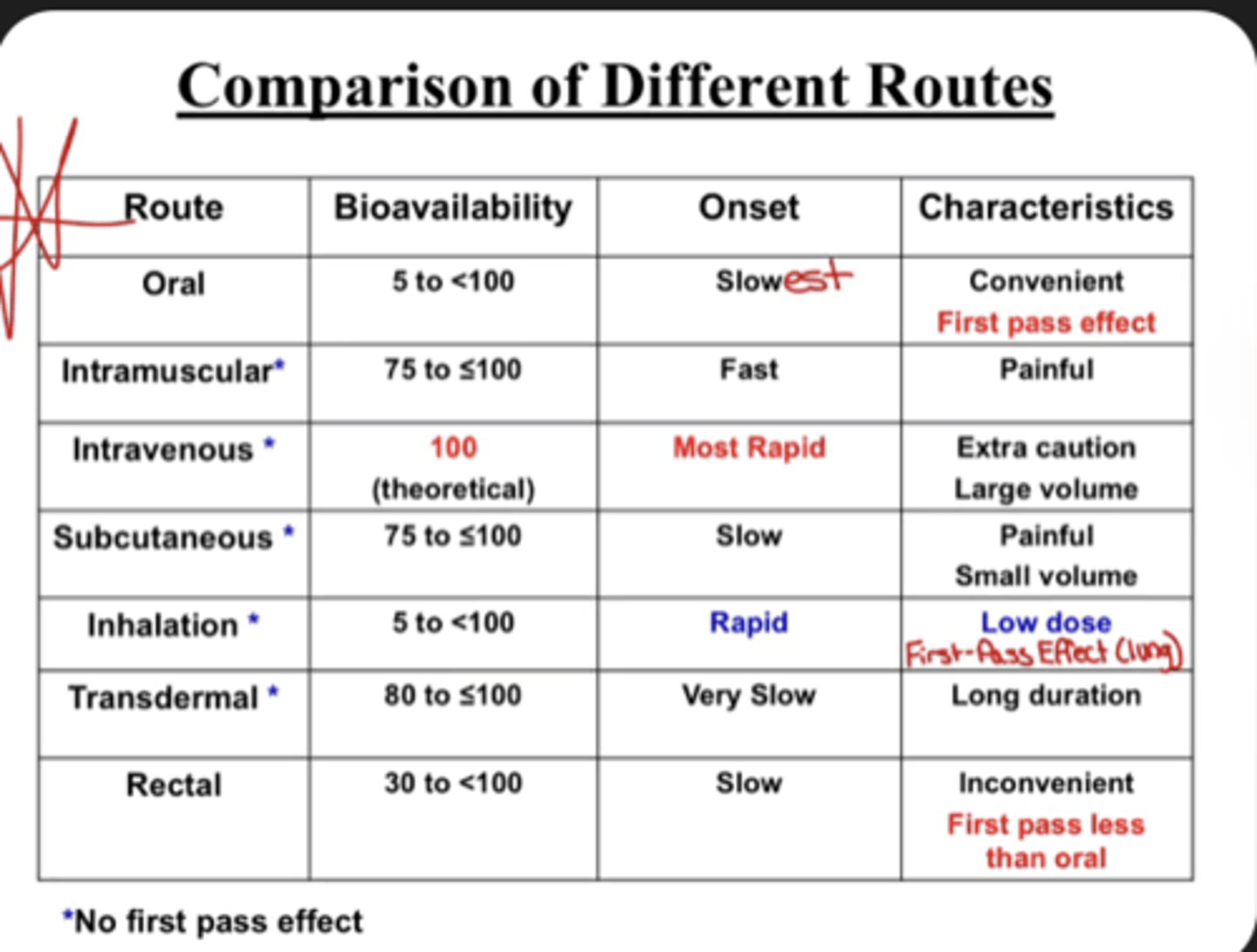
Comparison of different routes (chart) ***: Subcutaneous SC
Bioavailability:
Onset:
Characteristics (2):
Bioavailability: 75 to <100
Onset: Slow
Characteristics: painful, small volume
- NO FIRST-PASS
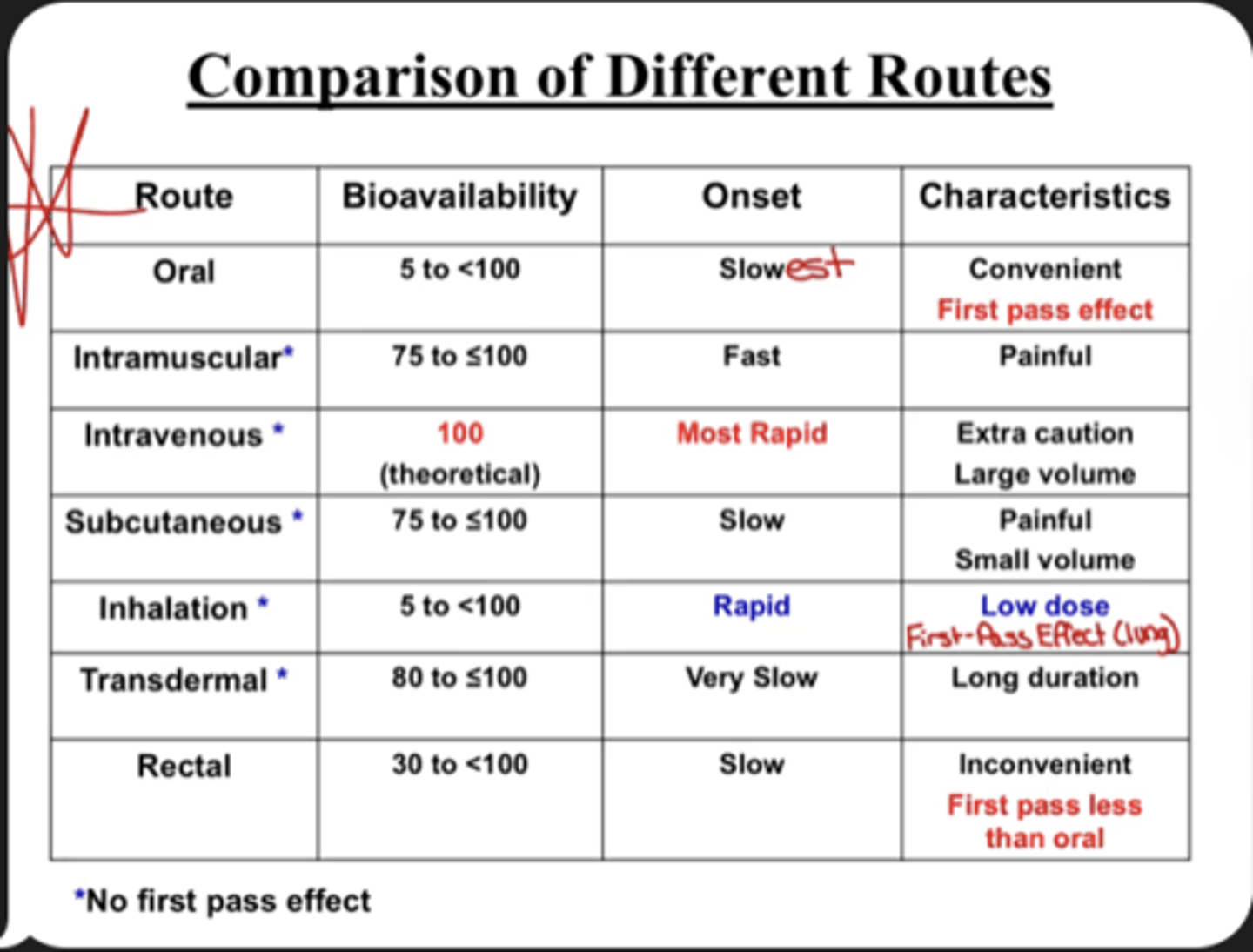
Comparison of different routes (chart) ***: Inhalation
Bioavailability:
Onset:
Characteristics (2):
Bioavailability: 5 to <100
Onset: Rapid
Characteristics: Low dose, first-pass effect (lung)

Comparison of different routes (chart) ***: Transdermal
Bioavailability:
Onset:
Characteristics (1):
Bioavailability: 80 to <100
Onset: Very slow
Characteristics: Long duration
- NO FIRST-PASS
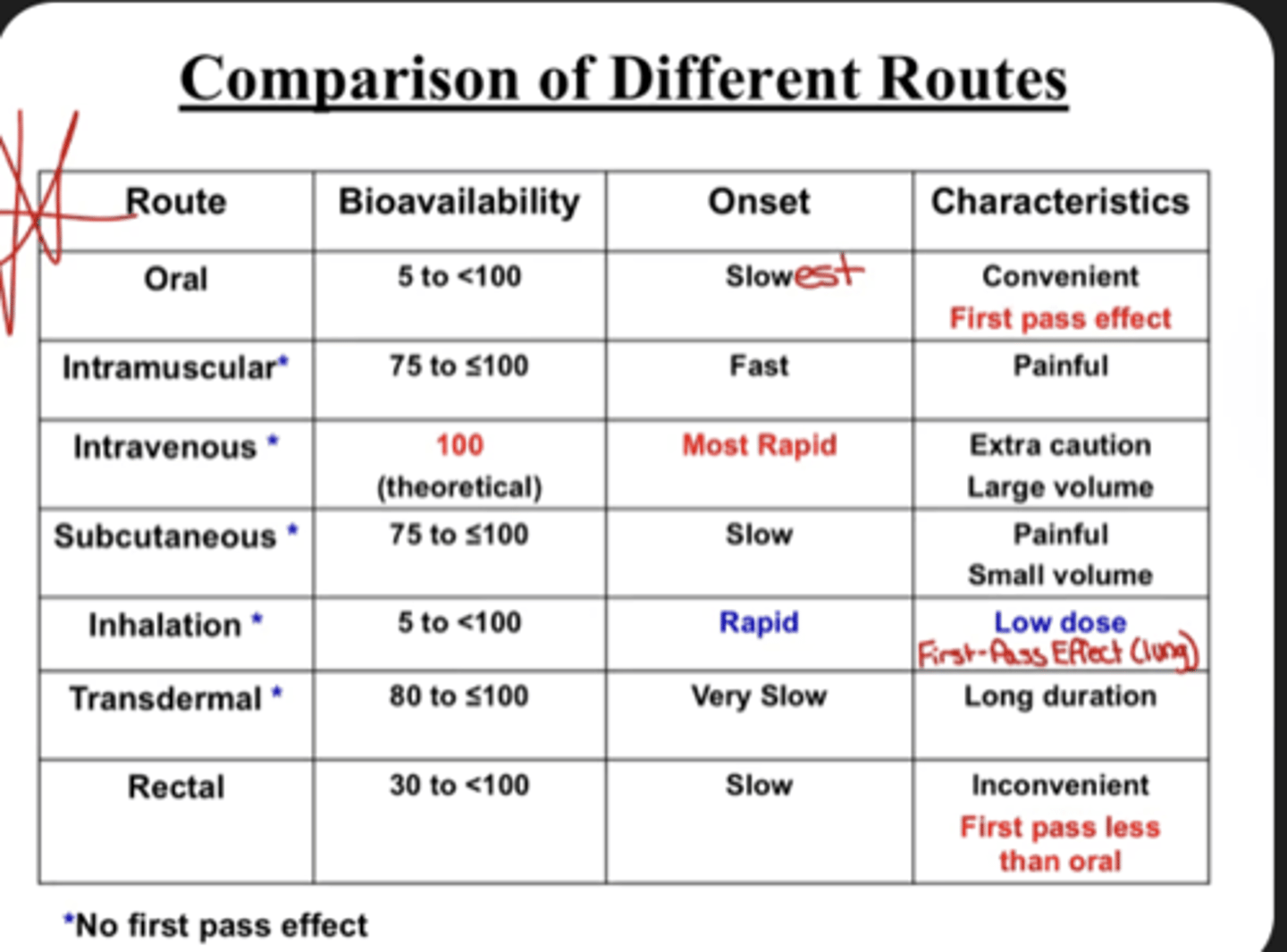
Comparison of different routes (chart) ***: Rectal
Bioavailability:
Onset:
Characteristics (2):
Bioavailability: 30 to <100
Onset: Slow
Characteristics (1): Inconvenient, first-pass less than oral

Pediatric dose changes for different illnesses or as the PT grows requires....
age-dependent adjustments (Young’s Rule)
T/F: Many drugs currently in use in pediatrics have established dosing recs based on weight, BSA, concurrent drug therapy, and stage of development or age
TRUE
What is the most common method for pediatric dosing?
Body weight–based dosing
- (Dose/Bodyweight & Clark’s Rule)
Controlled dosing
slowly releasing into the bloodstream
What are examples of life-and-death situations is it important to reach the bloodstream quickly? (4)
- anaphylactic shock
- heart attack
- poisoning
- stroke